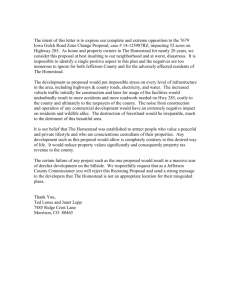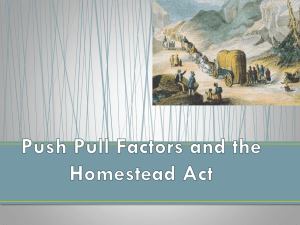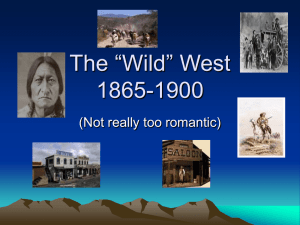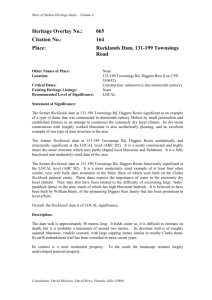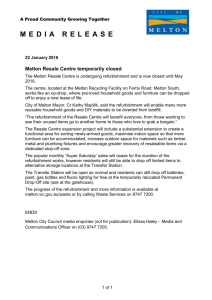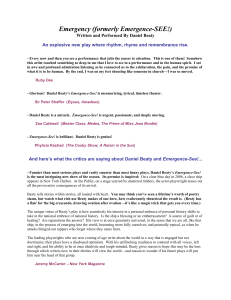Rocklands - Melton.vic.gov.au
advertisement
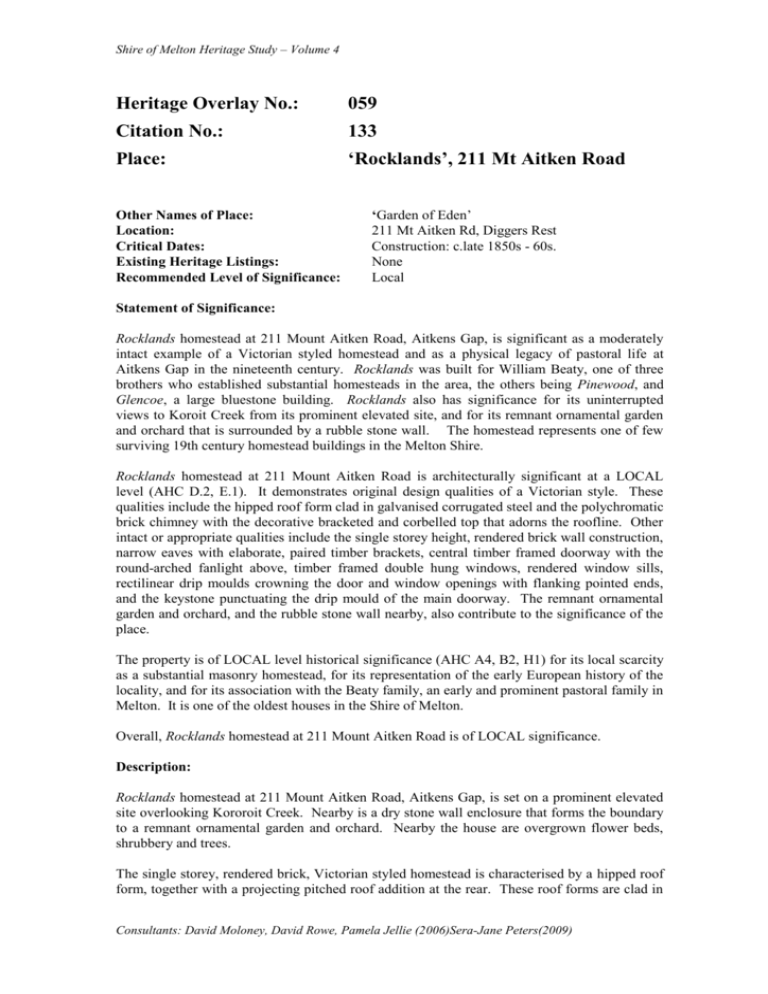
Shire of Melton Heritage Study – Volume 4 Heritage Overlay No.: 059 Citation No.: 133 Place: ‘Rocklands’, 211 Mt Aitken Road Other Names of Place: Location: Critical Dates: Existing Heritage Listings: Recommended Level of Significance: ‘Garden of Eden’ 211 Mt Aitken Rd, Diggers Rest Construction: c.late 1850s - 60s. None Local Statement of Significance: Rocklands homestead at 211 Mount Aitken Road, Aitkens Gap, is significant as a moderately intact example of a Victorian styled homestead and as a physical legacy of pastoral life at Aitkens Gap in the nineteenth century. Rocklands was built for William Beaty, one of three brothers who established substantial homesteads in the area, the others being Pinewood, and Glencoe, a large bluestone building. Rocklands also has significance for its uninterrupted views to Koroit Creek from its prominent elevated site, and for its remnant ornamental garden and orchard that is surrounded by a rubble stone wall. The homestead represents one of few surviving 19th century homestead buildings in the Melton Shire. Rocklands homestead at 211 Mount Aitken Road is architecturally significant at a LOCAL level (AHC D.2, E.1). It demonstrates original design qualities of a Victorian style. These qualities include the hipped roof form clad in galvanised corrugated steel and the polychromatic brick chimney with the decorative bracketed and corbelled top that adorns the roofline. Other intact or appropriate qualities include the single storey height, rendered brick wall construction, narrow eaves with elaborate, paired timber brackets, central timber framed doorway with the round-arched fanlight above, timber framed double hung windows, rendered window sills, rectilinear drip moulds crowning the door and window openings with flanking pointed ends, and the keystone punctuating the drip mould of the main doorway. The remnant ornamental garden and orchard, and the rubble stone wall nearby, also contribute to the significance of the place. The property is of LOCAL level historical significance (AHC A4, B2, H1) for its local scarcity as a substantial masonry homestead, for its representation of the early European history of the locality, and for its association with the Beaty family, an early and prominent pastoral family in Melton. It is one of the oldest houses in the Shire of Melton. Overall, Rocklands homestead at 211 Mount Aitken Road is of LOCAL significance. Description: Rocklands homestead at 211 Mount Aitken Road, Aitkens Gap, is set on a prominent elevated site overlooking Kororoit Creek. Nearby is a dry stone wall enclosure that forms the boundary to a remnant ornamental garden and orchard. Nearby the house are overgrown flower beds, shrubbery and trees. The single storey, rendered brick, Victorian styled homestead is characterised by a hipped roof form, together with a projecting pitched roof addition at the rear. These roof forms are clad in Consultants: David Moloney, David Rowe, Pamela Jellie (2006)Sera-Jane Peters(2009) Shire of Melton Heritage Study – Volume 4 galvanised corrugated steel (the roof of the original house is currently painted green). An early polychromatic brick chimney with a decorative bracketed and corbelled top adorns the roofline. Narrow overhangs and elaborate, paired timber brackets are features of the eaves. The front of the house has a symmetrical composition. There is an early central timber framed doorway with a round-arched fanlight above. The timber and glazed door has been introduced. Flanking the doorway are timber framed double hung windows that have early rendered sills. There are similar windows on other facades. Another early decorative feature of the design are the drip moulds crowning the door and window openings. These moulds are largely rectilinear in form and have flanking pointed ends. The arched underside of the drip mould above the doorway fanlight is punctuated by a slightly projecting keystone. A verandah may be missing across the front of the dwelling. Below the homestead, in the valley of the creek, there is a substantial squared dry stone wall enclosure, with remnant plum trees (Prunus domestica), possibly later seedlings of originals. Its proximity to the house, water, and good drainage suggests that this originally enclosed a vegetable garden, to which fruit trees were added later. The present owner advises that the original orchard, with three remnant pear trees, was near the early quarry overlooking the Kororoit Creek, some distance south of the house. The enclosure contributes to the significance of the site.1 Near the house is a small Aleppa pine. History: John Beaty arrived in the colony from Co Tyrone, Ireland in 1848,2 and purchased a large allotment at one of the first sales of Crown Land in the district. In August 1852 he purchased the first, and largest, of numerous Crown Allotments he was soon to acquire in the Black Hill Road area. Crown Allotment 20 of 482 acres, Parish of Holden, was purchased jointly with a ‘John Beattie’, for the very good price of ₤578. Five months later, in January 1853, John Beattie sold John Beaty his half share in this allotment for ₤1446.3 (Beattie may have been a relation of John Beaty, as different branches of the family adopted different spellings. For example John Beaty met his brother Charles when he arrived in Melbourne from Ireland in 1856, but Charles used the spelling ‘Beatty’, which changed over time to ‘Beattie’.4 Beattys Road in Rockbank is named after Charles’ branch of the family. Official government records add to the confusion by often spelling John Beaty as ‘Beatty’, and sometimes ‘Beattey’. Confusion is further increased by Henry Beattie, who managed, and eventually partly owned, the adjacent Mt Aitken Station and other nearby property, but who hailed from Scotland5 and was presumably no relation to John Beaty. Henry and his sons, including William and John Aitken Beattie, became nationally famous breeders of 1 Mr Monty Russell, personal conversation, 15/2/2006. Starr, op cit, p.29. There is some suggestion that the Beaty may have been in possession of the property from 1848 (John Beaty, personal conversation, 8/5/2002) 3 PROV Torrens Application file: VPRS 460/P0 (39493). 4 Starr, loc cit. International ‘Beatty’ family websites also encompass all spellings of the surname (although male and female Christian names recur constantly in the nineteenth century). 5 Peck, HH, Memoirs of a Stockman, (Stock & Land Publishing, Melbourne, 1972), p. 99. 2 Consultants: David Moloney, David Rowe, Pamela Jellie (2006)Sera-Jane Peters(2009) Shire of Melton Heritage Study – Volume 4 Hereford cattle, Shropshire sheep, and Leicester and Merino crosses. Another son Walter also owned land in the district.6) Beaty had done well to establish in this early pastoral area, with Green Hills on his west, the famous early squatter and sheep breeder John Aitken to his north and east, and the notorious WJT (Big) Clarke to his south. By 1854 Beaty had a well-established ‘homestead’ on his allotment, situated the east bank of the West Branch of Kororoit Creek. 7 At Crown Land sales between 1854-57, Beaty capitalised on his foothold and purchased the majority of his holding a further 1547 acres. He purchased 15 separate but contiguous parcels of land, some of which cost, in this gold-rush period, over ₤4 per acre. In total Beaty acquired some 2030 acres (c.820 hectares) in the 1850s Crown sales. Most of this land was situated on the west side of the West Branch of Kororoit Creek, formerly part of the Green Hills Station, where the new Pinewood homestation, and Glencoe, would later be built. He also purchased another four allotments in the Parish of Holden, on the east side of the West Branch of the Kororoit Creek, originally part of the Mt Aitken Station, where his son William would later establish himself and build the Rocklands homestead.8 John Beaty senior divided his estate between his sons John junior, Andrew and William. John junior was apportioned (sold for a small sum) the property on West Branch of Kororoit Creek as far west as Blackhill Road, in 1872.9 On this land (about 716 acres by the late 1880s) the bluestone homestead Pinewood was built by John junior in 1875.10 In 1879 John senior and his wife Eliza transferred some 318 acres of land on the east side of the West Branch of Kororoit Creek (which had increased to some 739 acres in the late 1880s), to William (‘of Kororoit Creek, farmer’). This is where Rocklands homestead is built.11 The next day John senior transferred to Andrew Beaty the property (some 803 acres by the late 1880s) on which the Glencoe homestead is built.12 John senior retained some 600 acres in his own name,13 which was probably the site of his original homestead, of which all that remains is thought to be three pinus radiata, an old pear tree, and a hawthorn bush.14 William and his brother Andrew went back to Ireland where they both married before returning home.15 It is possible that the construction of Rocklands was associated with William’s marriage. Family sources advise that William was the eldest, considerably older than John junior, who did not marry until he was in his 40s. So it is thought likely that Rocklands was built quite a bit earlier than the house John junior built in 1875 (Pinewood), perhaps as early as the late 1850s.16 6 ibid, pp. 50, 99, 179-181; also Shire of Melton Ratebooks, 1882-1888. Lands Victoria, Put-Away Plan Y27 (1854) 8 Corwn allotments 3-5, Parish of Holden. 9 PROV Torrens Application file: VPRS 460/P0 (39493), Conveyance John Beaty to John Beaty the Younger,12/2/1872. 10 Shire of Melton Ratebooks, 1887-1888. 11 PROV Torrens Application file: VPRS 460/P0, Unit 817 (48954), Conveyance John Beaty to William Beaty,19/9/1879; also Shire of Melton Ratebooks, 1887-1888. 12 PROV Torrens Application file: VPRS 460/P0 (37508), Conveyance John Beaty to Andrew Beaty, 20/9/1879; also Shire of Melton Ratebooks, 1887-1888. 13 Shire of Melton Ratebooks, 1887-1888. 14 John Beaty, personal conversation, 8/5/2002. 15 ibid 16 John Beaty, personal conversation, 25/10/2004. Further family genealogical information on marriage dates etc might provide clues that would help to date the building. 7 Consultants: David Moloney, David Rowe, Pamela Jellie (2006)Sera-Jane Peters(2009) Shire of Melton Heritage Study – Volume 4 An early date for Rocklands is supported by the fact that William Beaty was already independently established on the property in 1864, as is evidenced by his purchase, from Hugh Glass and George Holmes at a mortgage auction, of two adjacent allotments of some 475 acres (originally owned by O.Connor and P.Phelan).17 All that can be definitely known from the Shire ratebooks is that the house was constructed by 1888. The early (and not so accurate) Melton Shire ratebooks list William Beaty as being in possession of 500 acres, owned by John Beaty, in 1873, and again in 1882. By 1887-88 the ratebooks list ‘William Beaty, Grazier, Buttlejorrk’, as being in possession of a ‘house and 739 acres’.18 However, this is not proof that the house was definitely built between 1882 and 1887, as the listing ‘buildings’ or ‘house’ was not practiced in the ratebooks for rural properties until 1887. Similarly it is not possible to come to any firm conclusion about the house having been constructed in the preceding year by the increase in property valuation which occurred at the time. All of the stone for the brothers’ Rocklands, Glencoe, and the new Pinewood homesteads is thought to have come from a quarry behind Glencoe.19 The garden, enclosed by a dry stone wall, was known in the Beaty family as the ‘Garden of Eden’.20 William Beaty had a son William James, and six daughters: Jane, Adie, Alice, Elizabeth, Violet and Sarah. John senior had died in November 1899, leaving his son William ‘Ryans Paddock’, some 350 acres to the west of Black Hill Road. Ratebooks continue to rate ‘William Beaty’ for the 775 acres plus house until at least 1920.21 In 1920 his daughters had sold their 374 acres to HG Townsing of New Gisborne for ₤4493. In 1929 William’s widow Eliza sold Rocklands to Henry George Townsing, (still ‘of Gisborne’) for ₤4310.22 Townsing moved in, and the road came to be named after him. Family member John Beaty was for 36 years a Melton Councillor, and served six terms as Shire President. ‘Beaty’s Bush Paddock’ was for many years the site of annual ‘Bird Day’ excursions for scholars at the nearby Toolern Vale State School.23 Thematic Context / Comparative Analysis: Shire of Melton Historical Themes: ‘Farming’, ‘Community’. Comparable Places in Melton: Historically, Rocklands is comparable to the other surviving substantial masonry homesteads owned by the Beaty family:- Glencoe homestead, and Pinewood homestead. Together, and with the dry stone walls in the vicinity of these homesteads, these mark the story of the early European development of the locality. 17 Torrens Application 48954, PROV VPRS 460 (Unit 817) Shire of Melton Ratebooks, 1872-73, 1882-83, 1887-88. 19 John Beaty, personal conversation, 8/5/2002. (Note however that was also a quarry on Rocklands.) 20 ibid 21 Shire of Melton Ratebooks, 1913-14, 1919-20 22 Torrens Application 48954, PROV VPRS 460 (Unit 817) 23 Toolern Vale State School Centenary History 1869-1969 (Toolern Vale State School Centenary Celebrations Committee, 1969), 18 Consultants: David Moloney, David Rowe, Pamela Jellie (2006)Sera-Jane Peters(2009) Shire of Melton Heritage Study – Volume 4 Glencoe appears to be more intact and substantial than Rocklands homestead, although the Victorian design is possibly not as elaborate in the detailing. Glencoe has a hipped roof form clad in galvanised corrugated steel, and a broken back encircling verandah supported by timber posts. It is constructed of bluestone and features timber framed double hung windows and an elaborate timber framed doorway with four panelled timber door, sidelights and highlights. Architecturally, Rocklands Homestead represents one of the earlier surviving mid nineteenth century homesteads in the Melton Shire. Other comparable examples are as follows: Strathtulloh homestead, Greigs Road, Melton South (Place Id. 286). This property was established in 1840, although the existing homestead was not built until c.1869. It shares similar Victorian design qualities as Rocklands, as noted in the broad hipped roof form, rendered chimneys, single storey appearance and encircling verandah. However, Strathtulloh is constructed of random coursed bluestone. There is also an early kitchen that forms part of the significant building fabric. This homestead is included on the Victorian Heritage Register. Eynesbury homestead, Eynesbury Road, Melton South (Place Id. 281). The original section of the homestead was built in the early 1870s. Unlike Rocklands, this Victorian styled dwelling is two storey and is Colonial Georgian in appearance, having been constructed of bluestone. Like Rocklands, the building has experienced additions, including the single storeyed bay windowed side wings that date from the 1880s and probably the concave verandah. This homestead is included on the Victorian Heritage Register. Exford homestead, 255 Exford Road, Melton South (Place Id. 269). The central portion of this homestead possibly represents the earliest surviving homestead building in the Melton Shire, having been constructed in c.1843 of pise. Unlike Rocklands, Exford is designed in what has been termed a Colonial Gothic style, a rare style in the Melton Shire. The building has an elongated hipped roof form with projecting dormer windows, together with a number of additions. This homestead is included on the Victorian Heritage Register. Glencoe homestead, 416 Blackhill Road (Place Id. 5). Built in c.1860s-70s, this dwelling features a similar broad hipped roof form as Rocklands, although the main roof terminates into a broken back encircling verandah. The roof is adorned by rendered masonry chimneys with multi-corbelled tops – the whole designed in a similar Victorian style. Unlike Rocklands, Glencoe is constructed of coursed squared rubble bluestone. The Willows, Nixon & McKenzie Roads, Melton (Place Id.226). This Victorian styled homestead was built in the mid 1850s in a rendered random rubble wall construction and with unusual sturdy projecting rendered buttresses. The hipped roof forms (the rear smaller hip having been added at an early time) are familiar with Rocklands, although the roof cladding has been introduced. Pinewood, Blackhill Road, Toolern Vale (Place Id.59). A Victorian styled, single storey, coursed, squared bluestone dwelling having a hipped roof form clad in slate tiles and a return bullnosed verandah (which may have replaced an earlier verandah). Other early features include the rendered chimneys, narrow eaves, early timber framed central main doorway with highlight, and the flanking early timber framed double hung windows. Overall therefore, Rocklands represents an early example of a Victorian styled homestead in the Melton Shire, with unusual rendered wall construction. Historically and architecturally, it is comparable to Strathtulloh, Glencoe, The Willows and Pinewood homesteads, all of which however appear to be more intact. Consultants: David Moloney, David Rowe, Pamela Jellie (2006)Sera-Jane Peters(2009) Shire of Melton Heritage Study – Volume 4 Condition: Fair Integrity: Moderately intact Recommendations: Recommended for inclusion in the Melton Planning Scheme Heritage Overlay. Recommended Heritage Overlay Schedule Controls: External Paint Controls: No Internal Alteration Controls: No Tree Controls: No Outbuildings and/or Fences: Dry stone wall of former garden. Other Recommendations: Opportunities are available to reconstruct the early verandah, using any available historical photographs of the homestead. Consultants: David Moloney, David Rowe, Pamela Jellie (2006)Sera-Jane Peters(2009)
